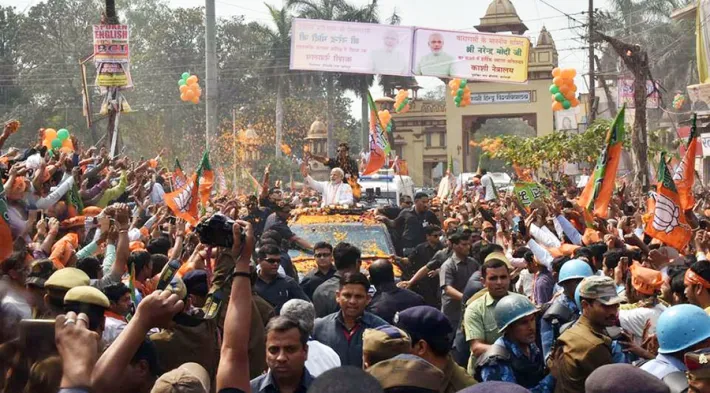
Perspectives August 14, 2017
Challenges New and Old Expose Cracks in India’s Democracy
As India marks 70 years of independence, its democratic institutions are suffering from weaknesses that the government has done little to address.

Narendra Modi. (Flickr/Creative Commons).
by Rukmani Bhatia, Research Coordinator, Freedom in the World & Freedom of the Press
As India marks 70 years of independence, its democratic institutions are suffering from weaknesses that the government has done little to address.
India has been designated as Free by Freedom in the World for almost 20 consecutive years, placing it among other high-ranking countries that generally uphold political rights and civil liberties.
The world’s largest democracy has long held regular elections on a massive scale, and undergone peaceful transfers of power from one government to the next. The electoral process is not without its flaws, with reports of corruption, vote buying, and harassment indicating that there is still ample room for improvement. But elections have generally remained peaceful and competitive in recent years, allowing for the rise and fall of multiple parties and coalitions at the state and national levels.
Indeed, the 2014 victory of current prime minister Narendra Modi and his right-leaning, Hindu nationalist Bharatiya Janata party (BJP) may have dealt a fatal blow to the center-left Indian National Congress party’s traditional dominance of national politics. Congress had governed for most of the period since independence, with only brief interruptions before the 1990s, though it had increasingly relied on a coalition of smaller parties to maintain a majority.
Under Modi, the government has taken significant steps to address the rampant culture of corruption in India, with Modi himself noting that “corruption and black money have destroyed the Indian democracy, eating into it like a termite.” On November 8, 2016, his administration implemented a demonetization policy that eliminated all 500- and 1,000-rupee notes in circulation. The goal of this drastic measure was to remove hoards of untaxed, unmonitored “black money” from the system. It was praised in some quarters, though it resulted in a cash shortage, with long lines at banks as people sought to exchange or withdraw money.
While Modi has made some progress on corruption and other reforms designed to strengthen the economy, such as the Goods and Services Tax launched in 2017, his government has so far neglected or exacerbated a range of other challenges to India’s democracy:
- Hindu ultranationalism: Religious vigilantism appears to be on the rise as Hindu extremists target Muslims and Dalits suspected of slaughtering cows, which are sacred to Hindus. Fatal “beef lynchings” have become more common occurrences. Modi has occasionally criticized the attacks, but other BJP politicians have taken more radical positions, and BJP-led state governments are implementing tighter restrictions on the sale of beef, seemingly making common cause with the vigilantes. The degree to which the ruling party has tolerated or encouraged extremism raises broader concerns about India’s future adherence to democratic norms.
- Censorship: The constitution guarantees freedom of expression, and the news industry is diverse and robust, but the media are routinely censored for language or images that are believed to violate public decency and morality. Secularist voices and those critical of Modi have been violently attacked and in some cases silenced. Some BJP lawmakers consider “antinational” speech to be outside the scope of the constitution’s free speech protections. Constraints on political discussion at college campuses are alarming, sometimes resulting in violent clashes with nationalist student groups. Deliberate internet blackouts are less common in India than in some other countries, but in 2016, India had the highest number of state-wide shutdowns globally; in 2017, it has already seen at least 20 instances of localized internet blackouts. There is a growing fear that free speech is eroding in India, and the government’s silence regarding direct attacks on freedom of expression suggests that the problem could worsen over time.
- Insurgency and counterinsurgency: Regional insurgencies continue to threaten the security situation in some parts of India. They include separatist movements in the northeast, Maoist rebels scattered across the central and eastern region, and militants in Indian-controlled Kashmir who seek independence or union with Pakistan. Upticks in violence by insurgents are typically met with a harsh police or military crackdown on the affected area, with civilians often suffering the consequences.
- Sexual violence and impunity: Sexual violence remains rampant, and reported instances of rape have increased since 2012. Politicians have acknowledged the problem and taken symbolic steps to address it, but very little has been done at an institutional level. A meaningful solution would require thorough reform of India’s police force and criminal justice system. New laws to tackle sexual violence cases more rigorously have been flawed, spousal rape has yet to be criminalized, and prosecution rates for sexual violence cases remain low.
- Threats to civil society: In recent years, India has seen its vibrant civil society space begin to shrink, with crackdowns on foreign funding that restrict the activity of nongovernmental organizations (NGOs) in the country. Modi’s government has also created more obstacles for license renewals, affecting NGOs that are critical of the authorities or whose work clashes with BJP ideology.
India today remains the world’s largest democracy, but it is clearly facing serious threats. While anticorruption measures and economic reforms may be necessary, they are insufficient to ensure that all Indians continue to enjoy the benefits of a free and democratic society.